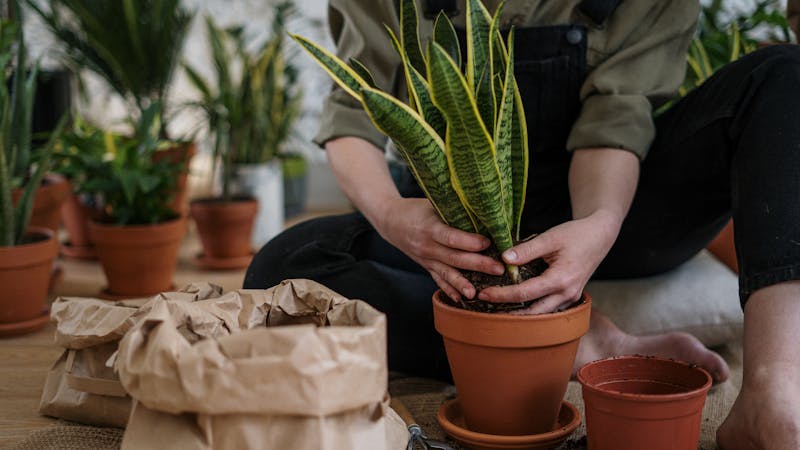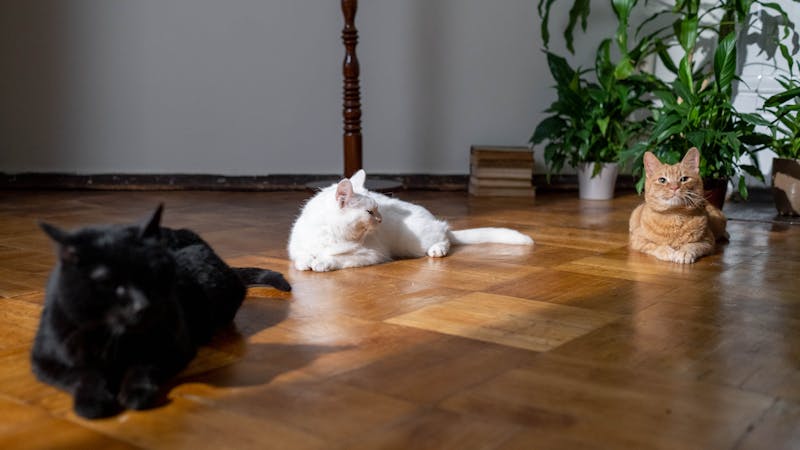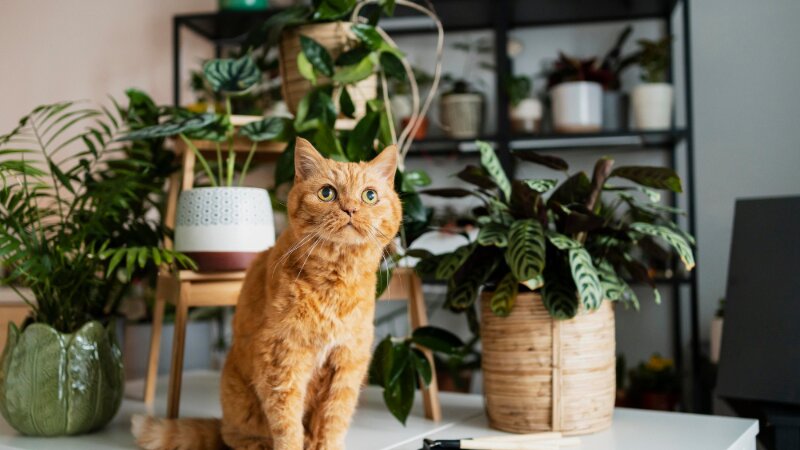Are Snake Plants Toxic to cats, lets read and see how it works for, Houseplants have become an important part of home decor, not only for their aesthetic appeal but also for their ability to purify indoor air. The snake plant (Sansevieria trifasciata), often known as “mother-in-law’s tongue,” is a popular choice due to its sleek appearance, low maintenance requirements, and air-purifying properties.
However, for pet owners, especially cat lovers, safety is a top priority when choosing indoor plants. If you’re a cat parent, you may be asking, “Are snake plants toxic to cats?”
This article aims to address this question in depth. We’ll explore whether snake plants toxic to cats, signs of poisoning, what to do if your cat eats part of the plant, and safe plant alternatives. Read on to ensure a harmonious and safe home for both your green thumb and your feline friend.
Section 1: What is a snake plant?
The snake plant (Sansevieria trifasciata) is a hardy, upright houseplant that has found its place in many homes. Native to West Africa, this plant is distinguished by its long, sword-like leaves that grow vertically. Snake plants have gained popularity due to their tolerance of low light and irregular watering, making them a great choice for busy plant enthusiasts.

The snake plant, also known as Sansevieria trifasciata, is popular for indoor gardening due to its striking appearance and hardiness. With long, stiff leaves resembling swords, this plant can reach impressive heights and add a modern touch to any space. Sometimes, Snake plants are toxic and can be harmful to cats.
Originating in West Africa, snake plants thrive in various environments, including areas with low light and infrequent watering, making them ideal for busy people. Additionally, they are recognized for their air purification capabilities, improving indoor air quality by effectively filtering out harmful substances
One of the snake plant’s most appreciated qualities is its air-purifying ability. A NASA study shows that some houseplants, including snake plants, can help remove toxins from the air. While this makes them attractive, it raises concerns for pet owners: Is this plant safe for cats, or is Snake plants toxic?
Section 2: Are snake plants toxic to cats?
Unfortunately, the answer is yes. Snake plants toxic to cats. The plant contains a natural chemical compound called saponin, which is mildly toxic to both cats and dogs. Snake plants are a danger to feline companions, as they are truly poisonous to cats.

The presence of saponins within the plant – a natural chemical compound – contributes to this toxicity. Although saponins act to protect the plant from predators, they can cause a variety of health problems for pets if ingested. Symptoms of poisoning may include vomiting, diarrhea, and abdominal pain.
Cat owners should therefore be wary of the presence of snake plants toxic in their homes to ensure the safety of their furry friends. Saponin is a natural defense mechanism that plants use to protect themselves from insects, fungi, and other potential threats. Although it is beneficial to the plant, ingesting saponin can pose a risk to pets.
Understanding Snake plants toxic.
Snake plants toxic that can cause gastrointestinal irritation in animals, including cats when ingested. The body responds to these foreign compounds with various symptoms. Although snake plant poisoning is usually mild to moderate, pet owners need to recognize the symptoms of plant poisoning and take immediate action.
Saponins are a class of compounds found in many plants, including snake plants, that can be harmful when eaten by animals. In cats, saponins can cause gastrointestinal irritation, leading to symptoms such as nausea, vomiting, and diarrhea.
Although Snake plants toxic are generally considered mild, pet owners need to be aware of these effects and monitor their pets for any signs of distress following possible exposure. If a cat shows signs of poisoning, immediate veterinary attention may be necessary to ensure its health and well-being.
Section 3: Symptoms of Snake Plant Toxic in Cats
Symptoms usually appear quickly in Snake plants toxic within minutes to hours of ingestion. In many cases, the toxins in the snake plant can irritate a cat’s digestive system, causing immediate discomfort. Other symptoms may be mild at first but may worsen if left untreated.

Recognizing these symptoms quickly allows for rapid intervention, which is essential to minimize the effects of toxins on your cat’s health. Ingesting snake plants toxic can cause various symptoms depending on the amount consumed and the cat’s sensitivity. Some common symptoms of snake plant toxic in cats are:
Nausea and vomiting: Nausea and vomiting are often the first signs that can answer the question: Are Snake Plants Toxic to Cats? When a cat ingests a snake plant, its body reacts by trying to expel the irritant through frequent vomiting. The vomit may contain foam or plant material.
indicating that the plant’s saponins are irritating. This symptom can quickly lead to dehydration, especially if vomiting persists for a prolonged period, making rehydration vital.
Vomiting is usually frequent and may be accompanied by abdominal cramping as the body actively tries to eliminate the poison. If the cat has eaten something, the vomit may contain foam or plant material. This reaction can lead to dehydration, especially if vomiting continues for a long time, so rehydration may be necessary.
Diarrhea and Digestive Irritation: One of the clear indicators to ask Are Snake Plants Toxic to Cats? is when your feline exhibits diarrhea. The saponins in snake plants can irritate the digestive system, leading to loose, watery stools.
This frequent diarrhea not only increases the risk of dehydration but also results in the loss of essential nutrients. In severe cases, immediate veterinary attention is necessary to manage the symptoms and prevent further complications
With frequent diarrhea, essential nutrients can be lost, leading to further weakness. If the diarrhea is severe or prolonged, immediate veterinary attention may be needed.
Apathy: Are Snake Plants Toxic to Cats? One common sign of toxicity is excessive apathy or hypersalivation. When a cat ingests a snake plant, it may begin drooling excessively as its body produces more saliva to soothe the irritation. This hypersalivation often leads to behaviors like pawing at the mouth or lips.
Additionally, the discomfort can cause a noticeable lack of interest or engagement, as the cat focuses its energy on dealing with the toxin. Monitoring these symptoms closely is crucial to determine whether veterinary care is needed
Loss of appetite: Another clear indicator to ask is, Are Snake Plants Toxic to Cats? is a sudden loss of appetite. Digestive irritation caused by the saponins in snake plants can make eating uncomfortable, leading to a decline in energy levels and overall health.
Prolonged refusal to eat can result in rapid weight loss, especially in cats of smaller or larger sizes. Offering a soft, easily digestible diet might help reignite some interest in food once symptoms start to subside
Nutritional support may be necessary to prevent further loss. Early intervention with a soft, easily digestible diet may help to develop some interest in eating when symptoms subside
Lethargy: If you’re wondering, Are Snake Plants Toxic to Cats? lethargy is another symptom to watch for. Cats may appear unusually tired or withdrawn as they cope with the discomfort caused by snake plant ingestion.
They might be less responsive, avoiding movement or play, and opting to rest instead. As lethargy progresses, it’s essential to monitor your cat’s behavior and seek veterinary care if it worsens or if other symptoms appear. A vet can provide pain relief and fluids to support recovery.
After consumption, these symptoms typically show up a few hours later. Although the level of toxicity is usually mild, it is important to monitor your cat closely. In rare cases, cats may experience more severe reactions if they consume large amounts of the plant.
Section 4: What to do if your cat eats a snake plant
First, remove any remaining plant material from the cat’s environment immediately to prevent further ingestion. Next, try to identify the symptoms your cat is exhibiting, as this will help the veterinarian provide targeted care. Contact your veterinarian or an emergency animal poison control hotline for professional guidance.

If advised, bring your cat in for an evaluation to determine the severity and appropriate treatment. Prompt action can significantly improve the chances of recovery and reduce your cat’s suffering. If you discover or suspect that your cat has consumed a snake plant toxic part of a t, it is important to take immediate steps to ensure its safety. Here’s what you should do:
1. Remove access to the plant: Move your cat to prevent it from eating more of the plant. If possible, keep the snake plant toxic in an inaccessible place or on a high shelf. Move the plant to a safe, high place that your cat can’t reach, such as a high shelf or a closed room.
This proactive measure helps prevent excess ingestion and reduces the risk of worsening symptoms. Making sure all potentially harmful plants are out of your reach is an important step in creating a safe environment for your pet.
2. Watch for signs: Monitor your cat for any signs of poisoning, especially vomiting, diarrhea, and lethargy. Pay special attention to symptoms such as vomiting, diarrhea, or lethargy, as these may indicate the body’s response to toxins.
Early detection of these symptoms can help get timely veterinary care, which can greatly affect the outcome of the situation. Keeping a close eye on your cat can also help you provide important information to the veterinarian if needed.
3. Contact Your Veterinarian: If symptoms appear or you are unsure of dosage, call your vet. Be prepared to describe the symptoms and the approximate amount consumed. Provide them with detailed information about the symptoms you observed, the type of plant involved, and the approximate amount your cat consumed.
Your veterinarian can guide you through the next steps, which may include bringing your cat in for an exam or monitoring him at home. Prompt communication with a veterinary professional can be critical to effectively dealing with potential poisoning.
4. Treatment: Treatment may include supportive care, such as intravenous fluids to treat dehydration or medications to relieve symptoms such as vomiting. Depending on the severity of symptoms, additional intervention may be necessary, so it’s important to follow your veterinarian’s recommendations closely.
Prompt and effective treatment can help ensure your cat’s health and comfort after the incident Although there is no specific antidote for saponin poisoning, your doctor may recommend treatments such as:
Vomiting: In some cases, your doctor may induce vomiting to flush out toxins. This procedure is often done under professional guidance to ensure it’s safe and effective for your cat. Inducing vomiting can reduce the toxin load in your cat’s system, potentially alleviating the severity of symptoms.
This step is usually taken only if it’s deemed safe based on the time elapsed since ingestion and your cat’s health condition.
Activated charcoal: This can be given to prevent further absorption of toxins. Activated charcoal works by binding to toxins in the digestive tract, effectively stopping their spread and minimizing further harm. This treatment may be given under veterinary supervision to ensure proper dosage and effectiveness.
Activated charcoal can be a helpful intervention, especially in cases where other treatments may not directly neutralize the toxins
Fluids: Hydration can help your cat recover, especially if he’s had vomiting or diarrhea. Intravenous fluids may be provided by a veterinarian to help maintain hydration levels, prevent electrolyte imbalances, and support overall recovery.
Fluids can also aid in flushing toxins out of your cat’s system, promoting faster detoxification. Ensuring proper hydration can significantly improve your cat’s comfort and resilience throughout the healing process.
Supportive care: Sometimes, your cat needs to be given rest, fluids, and rest to help him recover. Supportive care may include monitoring your cat’s symptoms, providing a quiet space, and minimizing stress to enhance healing. Your veterinarian may also recommend a gentle, bland diet temporarily to reduce digestive strain.
This holistic approach ensures that your cat’s body has the resources it needs to overcome the toxic effects effectively.
Section 5: Preventing Cats from Snake Plants Toxic

Keeping a plant-loving cat away from poisonous plants can be difficult. Awareness of snake plant toxic and strategic placement are key to keeping your cat safe. By implementing a few precautions, you can enjoy planting without putting your cat’s health at risk. Being active is the best way to keep your cat safe and healthy.
The following advice will help you about snake plants toxic and keep your cat safe:
Keep plants out of reach: Snake plants toxic on high shelves or in rooms that are out of reach for your cat. Consider placing these plants in closed rooms or on elevated surfaces that are truly inaccessible. This simple step can go a long way in reducing the risk of exposure.
Training and prevention: You can use natural barriers like lemon peels around the base of plants, as cats dislike the smell. Cats generally dislike the smell of citrus, so placing lemon peels near plants can create an effective deterrent. Training your cat to stay away from certain areas can reinforce this protection, and snake plant toxic.
Alternative display options: Try wall-mounted planters, hanging baskets, or attached plant stands. These options keep the plant decorative but out of reach.
While these methods are helpful, remember that every cat is different. Some may lose interest in plants entirely, while others may persist. Consistent prevention and cat-proof options can help maintain a safe home.
Section 6: Safer Plant Alternatives for Cat Owners
Good news for cat owners: Many beautiful, non-toxic plants can replace snake plants toxic while offering similar decorative and air-purifying benefits. If you are apprehensive about the snake plants toxic risk, think about these alternative that are safe for cats.
Spider plant (Chlorophytum comosum): A hardy, cat-proof plant that also cleans the air. Spider plants grow well in indirect light, adding a lively green touch to any room.
Boston Fern (Nephrolepis exaltata): This lush, green plant thrives in humid environments, making it ideal for bathrooms. It is non-toxic and safe for cats.
Areca Palm (Dypsis lutescens): is a beautiful, cat-friendly plant that gives indoor areas a lush, tropical feel. Its elegant, feathery fronds are well-known for adding vivid foliage that instantly brightens any space.

This palm is non-toxic to cats, making it a perfect choice for pet owners who want to create a safe, green haven at home. It’s relatively easy to care for, thriving in bright, Unlike many other tropical plants, they can tolerate lower humidity levels and indirect light. The Areca Palm’s ability to filter the air also enhances indoor air quality, making the space healthier and more revitalizing.
Bamboo palm (Chamidoria elegans): Another air-purifying palm that is safe for cats and adds beauty to the decor.
Choosing cat-friendly plants can give you peace of mind while beautifying your space. Always verify the toxicity of plants before planting a new plant in your home.
Section 7: Frequently Asked Questions (FAQ)
Question 1: How many snake plants does a cat need to eat to get sick?

Even small amounts can cause symptoms in some cats, but the severity often depends on the amount that is ingested. Monitor your cat and consult a vet if any symptoms appear.
Q2: Are all parts of the snake plant toxic to cats?
Yes, all parts of the snake plant toxic contain saponins, which can cause mild discomfort if ingested by cats. However, with proper care and placement, you can easily enjoy the beauty of snake plants while keeping your furry friends safe.
Q3: What if I have both snake plants and cats? Can they stay together?
Absolutely! You can have both snake plants and cats coexisting harmoniously with a few precautions. By placing your snake plants in elevated or inaccessible areas.
Q4: Can snake plants toxic effects be fatal to cats?
Snake plants toxic effects are typically mild, and fatal cases are extremely rare. However, severe symptoms can occasionally occur, depending on the amount ingested and the cat’s sensitivity.
Q5: How can I tell if my cat is more likely to chew houseplants?
Some cats are naturally curious and may tend to explore by chewing on plants. Offering safe grass or catnip can help satisfy their curiosity.cd
Section 8: Summary and Concluding Remarks
To understand, while the snake plants toxic effects on cats are mild to moderate due to the presence of saponins, symptoms are usually manageable with prompt care. Pet owners should be careful and choose safe plants for their homes. By making informed choices, you can enjoy a lush indoor garden without compromising your cat’s health.
With prompt and attentive care, the symptoms caused by Snake plants toxic properties are often manageable and less likely to cause serious complications. Pet owners should prioritize safety by choosing non-toxic plant varieties, contributing to a cat-friendly home environment.
Remember:
• Snake plants toxic can be poisonous but usually cause only mild to moderate symptoms.
• If ingestion occurs, monitor your cat closely and consult a veterinarian as needed.
• Consider cat-safe plant alternatives such as spider plants, Boston ferns, and bamboo palms.
Conclusion

Pet ownership requires thoughtfulness in all aspects of home maintenance, including houseplant selection. Knowing that snake plants toxic are and poisonous to cats can help you make informed decisions and that safer alternatives are widely available. By choosing pet-friendly plants and taking precautions, you can create a beautiful, vibrant space that’s safe for your cat, and away from snake plants toxic.
Understanding the dangers of certain plants, such as snake plants toxic, enables you to make safer decisions for your pet’s health. Choosing non-toxic, cat-friendly plants lets you enjoy greenery without compromising your cat’s safety. By taking proactive steps, you can cultivate a space that is both aesthetically pleasing and safe for your beloved pet


